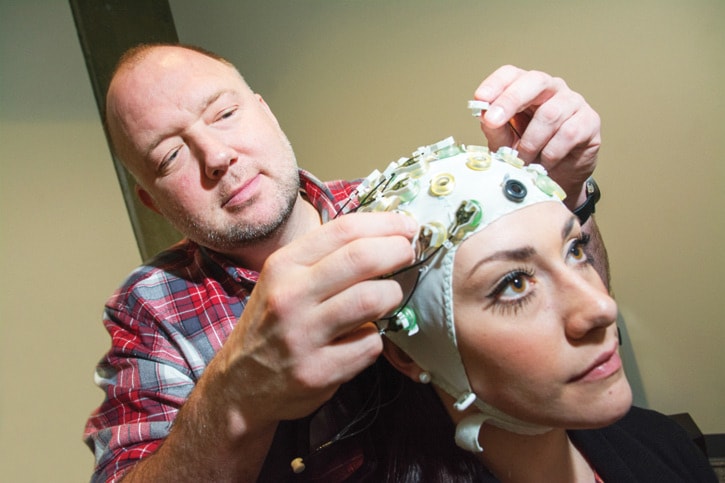Think we learn by our mistakes?
Think again.
Neuroscientist Dr. Olav Krigolson studies learning and decision-making in the Neuroeconomics Laboratory at the University of Victoria.
“The biggest thing I’ve learned is you don’t learn from your mistakes, you learn when your expectations deviate from an expected outcome,” says the 1988 Salmon Arm Senior Secondary grad.
The process holds true for big-picture decisions and a myriad of small, everyday choices, Krigolson says. And every choice has a value.
For example, you order a pizza from a pizza restaurant, fully expecting it to be delicious. The value is your expectation.
If the pizza is terrible, your value changes and you will likely not order from the same place again.
On the other hand, if the pizza meets expectations, the value remains the same.
In the neuroeconomics lab, Krigolson and his students measure brain activity using electroencephalograms (EEGs) and magnetic resonance imaging (MRI).
Krigolson is collaborating on an exciting study with fellow SASS grad and longtime friend Kent Hecker, a professor in the Health Sciences Department at the University of Calgary.
The project involves decision-making among doctors.
“When they diagnose, doctors are faced with a number of value choices and we are looking at why they are making the choices they are making,” says Krigolson, noting experts tend to make more gut decisions and younger doctors are more analytical. “What we’re specifically looking at is brain activity to see if the theory matches up with what is actually happening in the brain.”
He says hunches are good when they are right, but by not examining all possible diagnoses and their probability based on evidence, doctors can miss vital information.
While it has long been known that analytical thinking takes place in the front of the brain and gut hunches show increased activity in the middle of the brain at the back of the head, Krigolson’s use of the EEG to measure activity is new.
Krigolson says he and Hecker are hoping to develop a portable EEG system that doctors can wear and will measure brainwaves in real time and send an alert to their telephones in the same way heart rates and other data are transferrable.
“It will show the region of the brain being activated and the amount of activity,” he says. “If the doctor makes a gut hunch decision, their phone will beep a warning to say ‘Hey maybe you should think about that.’”
Another exciting project will take place next month.
Krigolson has been asked to be part of a Canadian research team going to Mt. Everest in May where he will be collecting EEG data in order to examine the impact of extreme environments and altitude on learning and decision making.
“We will only be going up to base camp at 17,598 feet, but it has been a dream of mine to journey to Nepal and Everest since Grade 6 when I did a school project on Tenzing Norgay,” says Krigolson. “And now I finally get to realize that dream.”
While he is there, Krigolson will be testing the portability of the equipment by making daily assessments of the other team members, who are predominantly physiologists.
Krigolson’s road to a doctorate in neuroscience began with a knee injury he suffered while studying at Royal Roads Military College.
Enlisted in the infantry, he was given the choice of two other trades or a release from the military.
He chose to leave and enrolled in Camosun College in Victoria before switching to the University of Victoria to finish his degree in education.
Krigolson taught two years in Victoria and two in England before accepting a professor’s advice to go to grad school.
That led him, on full scholarship, to a college in Indiana, where he pursued a science degree.
“It came together there; I took an elective in neuroscience and got hooked,” he says. “I was fascinated about the changes that happen in the brain when people learned and that’s what I chased after.”
Armed with a masters in science, Krigolson got a position in a then-new brain imaging lab at UVic, earning a PhD in neuroscience and followed it up with a post-doctoral research fellowship at UBC and a four-year teaching post at Dalhousie University.
“Then a job opened up in Victoria and I decided it was time to come home,” he says.
While he doesn’t get back to Salmon Arm very often, Krigolson says he still calls the community home.
